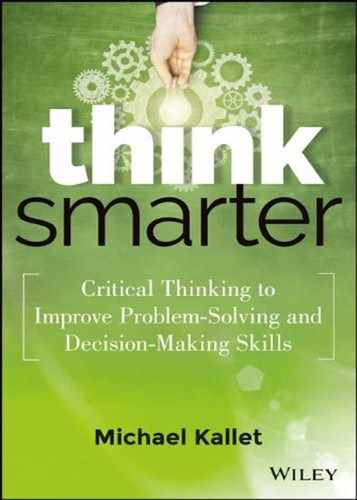Section IV Conclusions and Innovation
Ralph Waldo Emerson is credited with uttering, “Build a better mousetrap, and the world will beat a path to your door.” The process of using inductive reasoning that starts with a premise to form our conclusion usually produces sound, executable, and reliable solutions—better mousetraps.
But what happens if a better mousetrap is not enough? What if you want to produce a true breakthrough, a paradigm-changing solution? Let's say revenue is flat, and the only solutions seem to be more marketing dollars, more salespeople, or an incremental product line revision. Someone asserts during a meeting, “Come on folks; we need to think outside the box!” Everyone starts to scramble for outside-the-box solutions. The trouble is that to think outside the box, you first have to know what the box is.
We define innovation and creativity as providing a new or modified conclusion that obtains a positive result. Innovation might be a customized process, fresh product, different marketing approach, or different way of handling a customer call.
What's the difference between regular conclusions and innovative conclusions? Well, there's no checklist to help differentiate. If a solution works, the problem is solved. Of course, there are ways to solve a problem that result in different outcomes. For example, maybe your headscratcher is to increase sales by 5 percent. There may be several solutions, but only one might enable sales to grow by 20 percent or accomplish the growth in half the time. These more powerful solutions are considered more innovative than the mere 5 percent increase because the results are better. Innovation doesn't have to be a new invention; it just has to produce distinctive solutions.
There are three critical thinking tools we use to generate results significantly beyond what simple conclusions can yield:
- Thinking outside the box
- Abductive thinking
- Impossible thinking
I'll detail these techniques in the next three chapters. You can use them in a variety of situations, ranging from “I have no idea what to do” to “Is there something even better than this?” to “We need a breakthrough idea.” You won't use these techniques all the time, nor should you need to. The regular critical thinking process we use to reach conclusions via a premise should be sufficient—most of the time. That's where you should always start, because these other techniques rely on that process anyway.
Figure IV.1 illustrates the inductive or deductive premise-to-conclusions process we've already covered and how the new techniques enhance that process:

Figure IV.1 The World of Conclusions (Solutions)
This figure shows four ways to think critically to arrive at solutions. The first and primary method is our basic, highly productive deduction and induction: facts, observations, experiences, beliefs, and assumptions comprise your premise, which results in a conclusion. As we know, this tactic yields quality solutions. Beyond our primary method of solving problems is outside-the-box thinking; then beyond that you have abductive thinking—and even beyond that, something our company calls impossible thinking. We're still in the world of conclusions, which these new tools enhance.
Innovation isn't reserved for the select few who come up with brilliant new products and ideas. Yes, those are surely innovative, and we classify most of those ideas as inventions. Everyone, however, can be innovative, especially when using critical thinking as a foundation. So let's begin the first chapter of this section with the not-so-clear phrase “think outside the box.”
